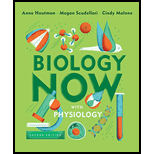
Concept explainers
An ecosystem is comprised of a group of living organisms (microorganisms, animals, and plants) and non-living organisms (water, air, and mineral soil). The ecosystem does not possess a well-defined physical boundary. Ecologists state the ecosystem in different ways based on its functions, particularly how the nutrients and energy are assimilated and disseminated by the living organisms.
Answer to Problem 1TQ
Nutrients continuously traveled between the living things (biotic) and non-living things (abiotic). The movement of nutrients among various organisms as well as the physical environment is known as nutrient cycling. Therefore, option (a) is correct.
Explanation of Solution
Justify reasons for the correct statement:
Chemicals are essential for effective growth and survival of the organisms in an ecosystem are referred as nutrients. A nutrient cycle is the continuous movement of nutrients from the physical surroundings into a living organism. Later, the nutrient is reprocessed back into the physical environment. Therefore, the movement of nutrients between physical environment and the living organism is termed as nutrient cycling.
Option (a) is given as “nutrient cycling”.
Hence, option (a) is correct.
Justify reasons for the incorrect statements:
Option (b) is given as “ecosystem services”.
Ecosystem services are categorized into four types. They are provisioning (water and food production), regulating (climate and disease control), cultural (recreational and health benefits), and supporting (oxygen production and nutrient cycles). Therefore, it is not directly associated only with nutrient cycle. Hence, it is a wrong answer.
Option (c) is given as “net primary productivity”.
The rate at which plants generate net essential chemical energy in an ecosystem is referred to as a net primary productivity. Therefore, it is not related to the nutrient cycle. Hence, it is a wrong answer.
Option (d) is given as “decomposition”.
It is the process of decay or rotting, which is achieved by the breakdown of complex organic compounds into simpler organic forms. Hence, it is a wrong answer.
Hence, options (b), (c), and (d) are incorrect.
The movement of nutrients between organism and the physical environment is termed as nutrient cycling.
Want to see more full solutions like this?
Chapter 21 Solutions
Biology Now with Physiology (Second Edition)
 Human Anatomy & Physiology (11th Edition)BiologyISBN:9780134580999Author:Elaine N. Marieb, Katja N. HoehnPublisher:PEARSON
Human Anatomy & Physiology (11th Edition)BiologyISBN:9780134580999Author:Elaine N. Marieb, Katja N. HoehnPublisher:PEARSON Biology 2eBiologyISBN:9781947172517Author:Matthew Douglas, Jung Choi, Mary Ann ClarkPublisher:OpenStax
Biology 2eBiologyISBN:9781947172517Author:Matthew Douglas, Jung Choi, Mary Ann ClarkPublisher:OpenStax Anatomy & PhysiologyBiologyISBN:9781259398629Author:McKinley, Michael P., O'loughlin, Valerie Dean, Bidle, Theresa StouterPublisher:Mcgraw Hill Education,
Anatomy & PhysiologyBiologyISBN:9781259398629Author:McKinley, Michael P., O'loughlin, Valerie Dean, Bidle, Theresa StouterPublisher:Mcgraw Hill Education, Molecular Biology of the Cell (Sixth Edition)BiologyISBN:9780815344322Author:Bruce Alberts, Alexander D. Johnson, Julian Lewis, David Morgan, Martin Raff, Keith Roberts, Peter WalterPublisher:W. W. Norton & Company
Molecular Biology of the Cell (Sixth Edition)BiologyISBN:9780815344322Author:Bruce Alberts, Alexander D. Johnson, Julian Lewis, David Morgan, Martin Raff, Keith Roberts, Peter WalterPublisher:W. W. Norton & Company Laboratory Manual For Human Anatomy & PhysiologyBiologyISBN:9781260159363Author:Martin, Terry R., Prentice-craver, CynthiaPublisher:McGraw-Hill Publishing Co.
Laboratory Manual For Human Anatomy & PhysiologyBiologyISBN:9781260159363Author:Martin, Terry R., Prentice-craver, CynthiaPublisher:McGraw-Hill Publishing Co. Inquiry Into Life (16th Edition)BiologyISBN:9781260231700Author:Sylvia S. Mader, Michael WindelspechtPublisher:McGraw Hill Education
Inquiry Into Life (16th Edition)BiologyISBN:9781260231700Author:Sylvia S. Mader, Michael WindelspechtPublisher:McGraw Hill Education





